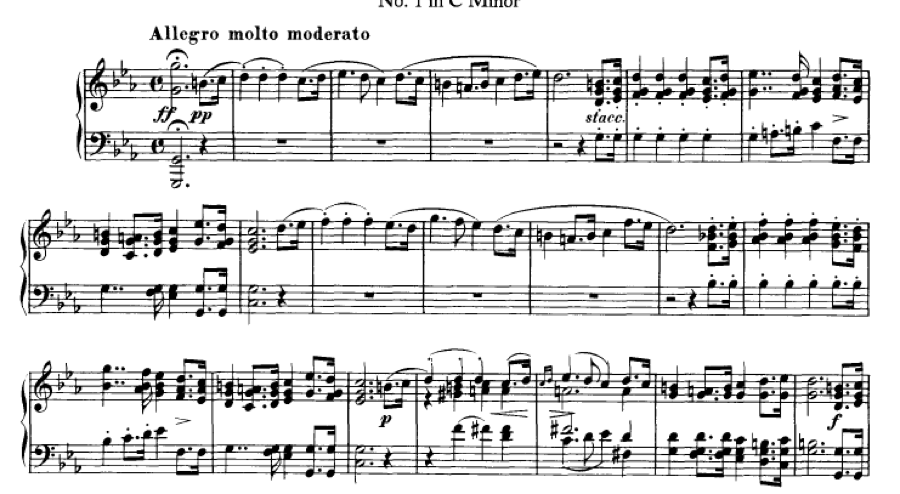Teaching Piano Students to Pedal, Part 3: The Portato Touch

Stringed instruments and their printed scores had been in existence for centuries before the piano was invented. When music started being written expressly for the piano many of the notational conventions of string music were carried over. Slurs and staccatos are found in the early works for piano by J.C. Bach, Haydn, Mozart, and others. The way to create these articulations is obviously different because of the differing methods for producing sound on these instruments. In this article we’ll explore just one articulation, portato, and the way to produce this on the piano.
The word “portato” is the past participle of the Italian verb “portare,” meaning “to carry,” or “carried” in the past tense. The sound is carried from one note to the next, not separated. The notation for this articulation is comprised of a slur over a group of notes, each of which has a dot, or staccato mark.
In string music slurs are specific indications for which notes composers would like to have played in a single bow. Placing the dots underneath the slur directed the player to add an impulse from the bow onto each note rather than slide smoothly through each one in a legato fashion. The dots were not indications to separate the notes, as they would have been had there not been a slur present. The sound one hears is connected notes with an added impulse on the dotted ones.
Mozart borrowed this existing notation in his piano music. Here is an example from his Fantasy in D Minor. See the first measure of the second line:

The way to produce the effect of connected notes with impulses is to use the pedal from the 2nd to the 3rd beat. The pedal carries the sound from note to note, while the separate strokes required by the dots add impulses to individual notes.
Playing staccato with the pedal depressed creates a sound that is different from any other sound one can produce at the piano. It is not the same as playing legato either with or without the pedal, and it was requested by composers of piano music who came afterward.
Beethoven used the same notation throughout his life. It can be found here, in the final movement of his very first piano sonata…

…as well as here, in his very last:

This example from the main theme of the Allegro of the Opus 111 Sonata demonstrates an instance where the difference between dots with slurs and dots without slurs is important interpretively. The measures with dots alone are played staccato, but the restatement immediately following is pedalled because of the portato indication, with one pedal for each eighth note and not a long pedal for the entire phrase.
Brahms adopted the same approach in the Ballade in G Minor from his Opus 118 collection of piano pieces. The two eighth notes at the very beginning are marked staccato, but those same upbeats on the third line are marked portato and are to be played with pedal. In this instance both eighth notes can be included in a single pedal that also sustains the bass.

Chopin was kind of enough to write a pedal marking under the first phrase of his first Nocturne. Here we see long slurs with mixtures of notes with and without dots, showing his awareness of the different sounds those two indications produced. On the second line of the following example he instructs us to change from legato to portato and then back again during the first long slur.

Schubert also used this notation throughout his works. In the first Impromptu of the Opus 90 collection the repeated notes in the main theme are marked portato. Connecting these notes with the pedal allows them coalesce into a melody that more closely matches the legato sound of the remainder of the phrase than separate notes could. Schubert carefully marks the following phrase staccato, showing he wanted a difference between that and the portato sound. The phrase marked staccato could still include the pedal, but with separations between each chord.

Debussy showed his expectation that the pedal would be used when the combination of slurs and dots were present right at the opening of the Prelude Les Collines d’Anacapri. The first measure uses this notation, then at the end of the bar he writes ties for all the notes, requiring the pedal to sustain all those tones. On the second line he uses a notation he created of ties leading to blank space to indicate that the pedal should be kept down. In both instances he writes in French for us to release the keys but to let the notes continue to resonate, which requires the pedal. Debussy’s pedal indications will be discussed in more detail in a future article in this series.

The notation for the portato touch is seen in every century of piano music. Later composers copied Mozart’s use of this notation in their own works, taking advantage of a sound the piano was capable of producing. Of course there are composers who understood the notation to mean something different, but in general students should be taught to use the pedal when they see this notation.





